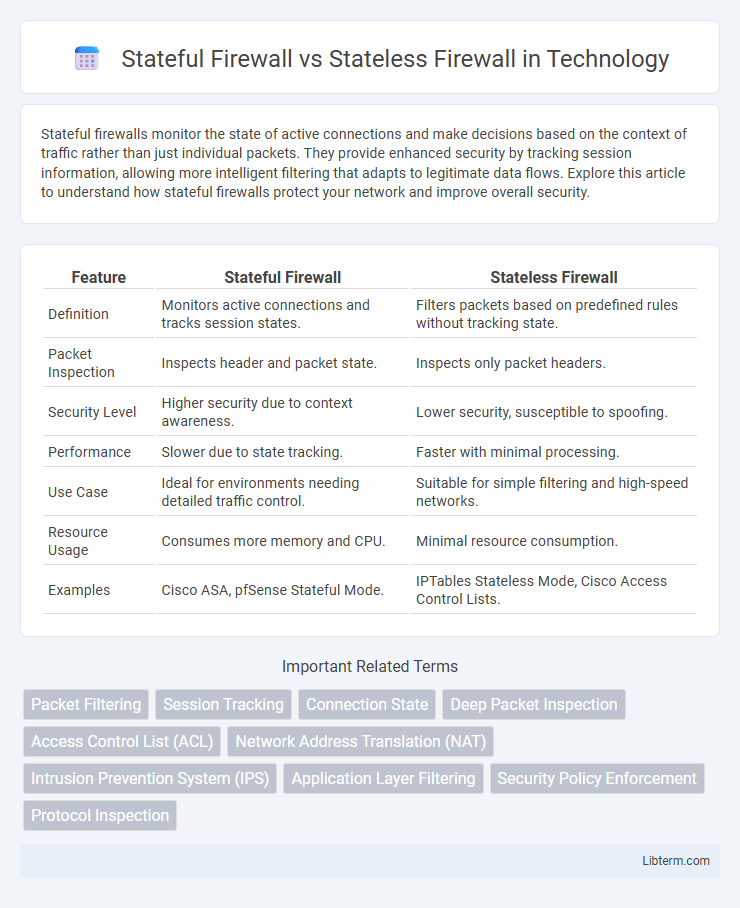Stateful firewalls monitor the state of active connections and make decisions based on the context of traffic rather than just individual packets. They provide enhanced security by tracking session information, allowing more intelligent filtering that adapts to legitimate data flows. Explore this article to understand how stateful firewalls protect your network and improve overall security.
Table of Comparison
| Feature | Stateful Firewall | Stateless Firewall |
|---|---|---|
| Definition | Monitors active connections and tracks session states. | Filters packets based on predefined rules without tracking state. |
| Packet Inspection | Inspects header and packet state. | Inspects only packet headers. |
| Security Level | Higher security due to context awareness. | Lower security, susceptible to spoofing. |
| Performance | Slower due to state tracking. | Faster with minimal processing. |
| Use Case | Ideal for environments needing detailed traffic control. | Suitable for simple filtering and high-speed networks. |
| Resource Usage | Consumes more memory and CPU. | Minimal resource consumption. |
| Examples | Cisco ASA, pfSense Stateful Mode. | IPTables Stateless Mode, Cisco Access Control Lists. |
Introduction to Firewalls
Stateful firewalls monitor the state and context of active connections, allowing them to make more intelligent decisions by tracking the entire communication session. Stateless firewalls, on the other hand, filter packets solely based on predefined rules without considering connection state, leading to faster but less context-aware filtering. Both types serve critical roles in network security by controlling traffic flow and preventing unauthorized access according to different operational needs.
What is a Stateful Firewall?
A stateful firewall monitors the full state of active network connections, allowing it to make more informed security decisions based on traffic context and history. It tracks packet information such as source, destination, port, and sequence number, ensuring that only legitimate, consistent packets are allowed through. This dynamic filtering provides enhanced protection against unauthorized access and network attacks compared to stateless firewalls, which inspect packets in isolation.
What is a Stateless Firewall?
A stateless firewall filters network traffic by examining individual packets independently without retaining any connection state information. It enforces rules based on preset criteria such as IP addresses, ports, and protocols, quickly blocking or allowing packets but lacking the ability to track the session context. This makes stateless firewalls faster but less secure compared to stateful firewalls, which monitor the entire connection state for more accurate traffic filtering.
Core Differences Between Stateful and Stateless Firewalls
Stateful firewalls monitor active connections and make decisions based on the context of traffic, maintaining session information to allow or block packets accordingly. Stateless firewalls filter packets independently without tracking connection states, relying solely on predefined rules such as IP addresses and port numbers. The core difference lies in stateful firewalls' ability to provide dynamic, context-aware security, whereas stateless firewalls offer faster, rule-based filtering without session awareness.
Performance Comparison: Stateful vs Stateless
Stateful firewalls track the state of active connections, offering enhanced security by inspecting packets within the context of a session, which can lead to higher resource consumption and potential latency under heavy traffic. Stateless firewalls, processing packets independently without maintaining connection states, deliver faster performance with lower resource usage but lack deep packet inspection capabilities, potentially allowing some threats to bypass filters. In high-throughput environments, stateless firewalls ensure minimal packet delay and maximum speed, whereas stateful firewalls prioritize security with moderate performance impact.
Security Capabilities: A Closer Look
Stateful firewalls analyze the entire context of network traffic by tracking connection states, enhancing security through deep packet inspection and connection monitoring to prevent unauthorized access and detect suspicious activities. Stateless firewalls, by contrast, filter packets solely based on predefined rules like IP addresses and ports without considering session information, resulting in faster performance but limited protection against sophisticated threats. The stateful approach offers superior defense against complex attacks such as session hijacking and DoS attacks due to its ability to maintain comprehensive traffic awareness.
Use Cases for Stateful Firewalls
Stateful firewalls are ideal for enterprise environments requiring deep packet inspection and continuous connection monitoring to detect and block sophisticated threats. Use cases for stateful firewalls include securing internal networks, managing outbound traffic policies, and providing robust protection for VPNs and web applications by tracking session states and ensuring only legitimate packets pass through. These firewalls excel in scenarios needing dynamic decision-making based on context, such as preventing intrusions during active sessions and responding to real-time threats.
Use Cases for Stateless Firewalls
Stateless firewalls offer fast packet filtering ideal for environments requiring simple rules and high throughput, such as in perimeter filters that block unwanted traffic based on IP addresses or ports without tracking connection states. They excel in scenarios where low latency is critical, like in high-speed network segments or devices with limited processing power. Stateless firewalls are suitable for protecting large networks from basic threats, enforcing static access control lists (ACLs), and handling traffic that does not require complex session monitoring.
Choosing the Right Firewall for Your Network
Stateful firewalls monitor the state of active connections and make decisions based on the context of traffic, providing enhanced security for dynamic network environments. Stateless firewalls filter packets based on fixed rules without considering connection state, offering faster processing but less comprehensive protection. Choosing the right firewall depends on network size, complexity, and security needs, with stateful firewalls preferred for most enterprise networks and stateless options suitable for high-speed, low-risk environments.
Conclusion: Which Firewall is Best for You?
Stateful firewalls offer enhanced security by monitoring the full context of network traffic, making them ideal for environments requiring deep packet inspection and dynamic filtering. Stateless firewalls, with their faster processing and simplicity, suit scenarios where speed and basic filtering suffice, such as edge protection in less complex networks. Choosing the best firewall depends on your network's security needs, performance requirements, and the complexity of traffic to be managed.
Stateful Firewall Infographic

 libterm.com
libterm.com